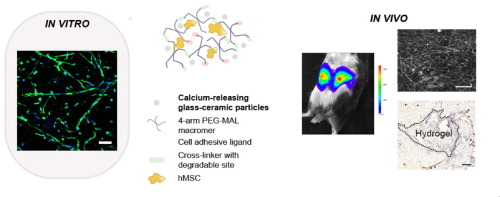Acta Biomaterialia ( IF 9.4 ) Pub Date : 2017-12-13 , DOI: 10.1016/j.actbio.2017.12.009 Claudia Navarro-Requena 1 , Jessica D Weaver 2 , Amy Y Clark 2 , Douglas A Clift 3 , Soledad Pérez-Amodio 1 , Óscar Castaño 4 , Dennis W Zhou 2 , Andrés J García 2 , Elisabeth Engel 1

|
The use of human mesenchymal stromal cells (hMSC) for treating diseased tissues with poor vascularization has received significant attention, but low cell survival has hampered its translation to the clinic. Bioglasses and glass-ceramics have also been suggested as therapeutic agents for stimulating angiogenesis in soft tissues, but these effects need further evaluation in vivo. In this study, calcium-releasing particles and hMSC were combined within a hydrogel to examine their vasculogenic potential in vitro and in vivo. The particles provided sustained calcium release and showed proangiogenic stimulation in a chorioallantoic membrane (CAM) assay. The number of hMSC encapsulated in a degradable RGD-functionalized PEG hydrogel containing particles remained constant over time and IGF-1 release was increased. When implanted in the epidydimal fat pad of immunocompromised mice, this composite material improved cell survival and stimulated vessel formation and maturation. Thus, the combination of hMSC and calcium-releasing glass-ceramics represents a new strategy to achieve vessel stabilization, a key factor in the revascularization of ischemic tissues.
Significance
Increasing blood vessel formation in diseased tissues with poor vascularization is a current clinical challenge. Cell therapy using human mesenchymal stem cells has received considerable interest, but low cell survival has hampered its translation to the clinic. Bioglasses and glass-ceramics have been explored as therapeutic agents for stimulating angiogenesis in soft tissues, but these effects need further evaluation in vivo. By incorporating both human mesenchymal stem cells and glass-ceramic particles in an implantable hydrogel, this study provides insights into the vasculogenic potential in soft tissues of the combined strategies. Enhancement of vessel formation and maturation supports further investigation of this strategy.
中文翻译:

含有钙释放颗粒和间充质基质细胞的PEG水凝胶促进血管成熟。
使用人间充质基质细胞(hMSC)治疗血管化不良的病变组织已受到广泛关注,但细胞存活率低阻碍了其向临床的转化。生物玻璃和玻璃陶瓷也被建议作为刺激软组织血管生成的治疗剂,但这些效果需要在体内进一步评估。在这项研究中,钙释放颗粒和 hMSC 组合在水凝胶中,以检查它们在体外和体内的血管生成潜力。这些颗粒提供持续的钙释放,并在绒毛尿囊膜(CAM)测定中显示出促血管生成刺激作用。封装在含有 RGD 功能化 PEG 水凝胶颗粒的可降解颗粒中的 hMSC 数量随时间保持恒定,并且 IGF-1 释放增加。当植入免疫功能低下小鼠的附睾脂肪垫时,这种复合材料可以提高细胞存活率并刺激血管形成和成熟。因此,hMSC和钙释放玻璃陶瓷的结合代表了实现血管稳定的新策略,血管稳定是缺血组织血运重建的关键因素。
意义
增加血管化不良的病变组织中的血管形成是当前的临床挑战。使用人类间充质干细胞的细胞疗法引起了相当大的兴趣,但低细胞存活率阻碍了其向临床的转化。生物玻璃和玻璃陶瓷已被探索作为刺激软组织血管生成的治疗剂,但这些效果需要在体内进一步评估。通过将人类间充质干细胞和玻璃陶瓷颗粒合并到可植入水凝胶中,这项研究提供了对组合策略在软组织中血管生成潜力的见解。血管形成和成熟的增强支持对该策略的进一步研究。










































 京公网安备 11010802027423号
京公网安备 11010802027423号